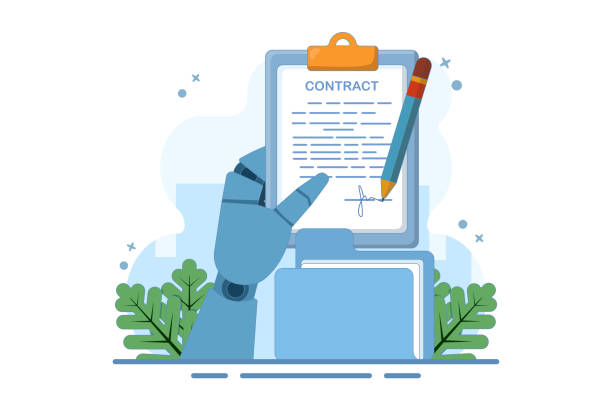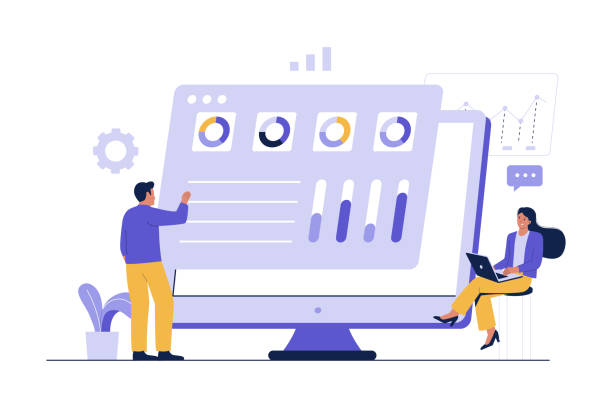An Introduction to the Importance of Multilingual Website Design and its Global Reach

In today’s world, where #internet has removed geographical boundaries, #online_presence is vital for every business.
But is this presence limited only to your mother tongue? The unequivocal answer is no.
#Multilingual_website_design is no longer a competitive advantage, but a necessity.
This approach allows you to connect with a wider audience from around the world and significantly expand your target market.
The importance of this issue is due to the unparalleled linguistic diversity in the world; millions of people worldwide use different languages for searching, buying, and interacting online.
If your website is only in one language, you will lose a huge portion of this global potential.
A multilingual website not only makes your information accessible to non-Persian speaking users but also shows your respect for their culture and language, which can build customer trust and loyalty.
From a business perspective, this action means potential sales increase, customer base expansion, and creation of new growth opportunities.
Companies that have pioneered this path have been able to secure a significant share of international markets.
In fact, multilingual website design is an investment that yields a significant return, as it facilitates communication with potential customers worldwide by removing language barriers, ultimately leading to brand expansion and increased profitability.
This helps you not only to deepen your presence in existing markets but also to open up new horizons for your business.
Are you disappointed with your online store’s low conversion rate?
RasawWeb is your definitive solution with professional e-commerce website design!
✅ Increase your sales and revenue
✅ Unmatched user experience for your customers
⚡ Get a free consultation right now!
Countless Benefits of Multilingual Websites for Your Business

Multilingual websites bring numerous benefits to businesses that go beyond merely connecting with more audiences.
One of the most important is increased market access.
Imagine your website is currently in Persian, and you intend to offer your products or services to Arab, European, or American countries.
Without multilingual website design, this would be almost impossible.
By providing content in different languages, you will be able to directly connect with potential customers in new markets.
This expanded access means increased website traffic and consequently increased sales opportunities.
Another advantage is improved SEO and search engine ranking.
When your content is available in various languages, the likelihood of appearing in user search results in different countries significantly increases.
This helps you rank not only for Persian keywords but also for similar keywords in other languages, which means attracting more targeted visitors.
Search engines like Google give higher scores to websites that offer a better user experience, and a multilingual site definitely contributes to this.
Also, the trust and credibility of your business increase with a multilingual website.
When a visitor from another country can find the information they need in their native language, they establish a deeper sense of trust and connection with your brand.
This demonstrates your professionalism and respect for international customers.
Consequently, the Conversion Rate also improves, as users are more inclined to purchase or use services offered in their language.
Ultimately, this approach allows your business to operate more competitively.
In global markets where competition is intense, providing a personalized and localized user experience can differentiate you from competitors.
By using multilingual website design, you will be able to gain a strong foothold in new markets and gradually increase your market share.
This is a long-term strategy for sustainable growth and success in the global arena.
Challenges and Solutions for Implementing Successful Multilingual Website Design

Implementing a successful multilingual website design, while offering many advantages, also comes with challenges that require careful planning and smart solutions.
One of the main challenges is content and translation management.
Accurate and high-quality translation of content into different languages is crucial, and merely using machine translation tools is not enough.
To ensure accuracy and correctness of meaning, especially in specialized or legal content, professional and localized human translators are needed.
Another challenge is technical and SEO aspects.
How to organize URLs for different languages (e.g., using subdomains, subfolders, or URL parameters), correctly implementing hreflang tags to inform search engines about different language versions of a page, and managing sitemaps for each language are specialized considerations that must be carefully observed to prevent issues with multilingual site SEO.
Also, User Interface (UI) and User Experience (UX) design for different languages is a challenge.
Some languages are written from right-to-left (like Persian and Arabic), and some from left-to-right.
This difference in direction can affect layout, element arrangement, and even font selection.
Ensuring that the user experience is consistent and optimized across all languages requires flexible design and multiple tests.
Solutions: For content management, using powerful Content Management Systems (CMS) with built-in multilingual capabilities (such as WordPress with plugins like WPML or Weglot, or Drupal) is very helpful.
For SEO, hiring an international SEO specialist who is familiar with the challenges of multilingual SEO is essential.
Finally, for UI/UX, responsive and flexible design, along with precise user testing in each language, can identify and resolve issues.
Below, you will see a comparative table of translation methods that will help you choose the best solution:
| Translation Method | Advantages | Disadvantages | Suitable For |
|---|---|---|---|
| Machine Translation (e.g., Google Translate) | High speed, low cost, suitable for general and non-sensitive content | Low accuracy, lack of localization and idiom understanding, low quality for specialized content | General content, less important sections of the site, initial translation for editing |
| Professional Human Translation | High accuracy, complete understanding of localization and culture, high quality, suitable for specialized and sensitive content | High cost, time-consuming, requires translation project management | Main site content, product/service pages, blog articles, marketing |
| Hybrid Translation (Machine + Human Editing) | Balance between speed, cost, and quality, improved accuracy compared to machine translation alone | Requires editing and review specialists, may still have imperfections | Blogs, product descriptions, FAQs, continuously updated content |
Choosing the Best Strategy for Content Translation and Localization

After understanding the challenges, it’s time to choose the best strategy for content translation and localization, which is one of the most vital parts of multilingual website design.
Mere word-for-word translation is not enough; content must be localized to align with the culture, idioms, and even emotions of the target audience in each language.
This process goes beyond mere translation and involves adapting content to the cultural, social, and legal characteristics of the target region.
For example, a marketing term that is very effective in one culture might be completely meaningless or even offensive in another.
The first strategy is to use specialized human translation.
This method is the most expensive and time-consuming, but it offers the highest quality and accuracy.
This method is recommended for core website content, key product descriptions, legal sections, or any content requiring high accuracy and precise brand message delivery.
Professional translators specializing in your specific business field can ensure that your message is conveyed correctly and with the appropriate tone.
The second strategy is machine translation with human editing (Post-editing).
In this method, content is first translated by a machine translation engine, and then a human translator reviews, edits, and refines it.
This method offers a balance between cost and quality and can be suitable for large volumes of content or content requiring fast translation.
However, the final quality depends on the quality of the initial machine translation and the editor’s skill.
The third strategy is crowdsourced translation.
Some platforms allow their users to contribute to content translation.
This method can significantly reduce translation costs and even help foster a sense of community involvement, but quality control is very difficult and may lead to inconsistent or low-quality translations.
This method is typically suitable for non-sensitive content or forums and communities.
In any strategy, localization goes beyond word translation.
This includes adapting currency, date and time formats, addresses, phone numbers, and even colors and images to ensure cultural compatibility.
The ultimate goal is to create an experience where the user feels the website was specifically designed for them, in their language and culture.
This integrated approach plays a key role in the success of multilingual website design and significantly improves the user experience.
Do you dream of a thriving online store but don’t know where to start?
RasawWeb is your comprehensive e-commerce website design solution.
✅ Attractive and user-friendly design
✅ Increased sales and revenue⚡ Get a free consultation
The Role of SEO in Multilingual Websites and Search Engine Optimization

SEO (Search Engine Optimization) in multilingual website design is not only more complex but also more vital than for single-language websites.
The goal is to ensure that search engines can easily identify different language versions of your content and display them to the appropriate users worldwide.
Without a strong SEO strategy, even the best translations may never reach the target audience.
One of the most important elements is the correct use of hreflang tags.
These tags inform search engines that different pages of your website are similar versions of each other in different languages or geographical regions.
This prevents the “duplicate content” issue and helps the search engine display the correct version of each page to local users.
Another key consideration is URL structure.
You can use subdomains (e.g., en.yourdomain.com), subfolders (e.g., yourdomain.com/en/), or even top-level domains (e.g., yourdomain.fr) for each language.
Each method has its own advantages and disadvantages in terms of SEO.
Google generally prefers subfolders due to ease of management and main domain authority transfer, but the final choice depends on the overall business strategy and scalability.
Keyword research must also be done separately for each language and geographical region.
Keywords that are effective in one language or culture might be ineffective in another.
Using multilingual keyword research tools and collaborating with native speakers to identify local and frequently used search phrases is essential.
This research not only helps optimize content but also identifies the specific needs of the target market.
Finally, Link Building must also be done locally.
Efforts to gain backlinks from reputable and relevant websites in each country can increase your website’s authority in that specific region and help improve the SEO ranking of that language version.
In summary, multilingual SEO is a complex but essential process that significantly contributes to increasing the visibility of your website in search engines on a global scale and is considered one of the main pillars of success in multilingual website design.
Practical Tools and Platforms in Multilingual Website Design

Choosing the right tools and platforms for multilingual website design can significantly impact the ease of implementation, management, and scalability of your website.
Today, there are numerous Content Management Systems (CMS) that support multilingual capabilities or can have this capability added through plugins and modules.
One of the most popular CMSs for this purpose is WordPress.
Although WordPress is not inherently multilingual, powerful plugins like WPML (WordPress Multilingual Plugin) or Weglot transform it into an excellent platform for multilingual sites.
WPML allows you to translate all types of content, including posts, pages, categories, tags, and even themes, and also provides translation management systems.
Weglot is a SaaS-based solution that combines automatic translation with manual editing options and quickly makes your website multilingual.
Drupal is another powerful CMS that has stronger multilingual capabilities by default than WordPress.
With its built-in modules and active community, Drupal offers comprehensive tools for multilingual content management, UI translation, and localization.
This platform is suitable for larger and more complex projects that require high flexibility.
For e-commerce projects, platforms like Shopify and Magento also offer multilingual capabilities.
Shopify, through multilingual-compatible apps and themes, and Magento, with built-in features for managing multilingual and multi-currency stores, provide the possibility of multilingual website design for online stores.
In addition to CMSs, other tools also exist to facilitate the translation and localization process.
Translation Management Systems (TMS) such as MemoQ or SDL Trados help translators and project managers make the translation process more efficient and ensure terminology consistency over time.
Using these tools significantly increases efficiency and accuracy in multilingual website design and helps create a high-quality international platform.
Review of Successful Cases and Lessons Learned in Multilingual Website Design

Reviewing successful examples of multilingual website design can be inspiring and a good guide for other businesses.
Large global companies like Airbnb and Netflix are shining examples of successful multilingual site implementations that have conquered the global market through deep localization.
Airbnb and Netflix have well understood that to attract users worldwide, simply translating content is not enough; the user experience must also be fully localized.
This includes images relevant to local culture, currency, payment systems, and even tone and communication style.
Lessons learned from these successful examples indicate that translation and localization quality is of paramount importance.
Using native-speaking and specialized translators in the relevant field ensures correct message delivery and avoids cultural misunderstandings.
Furthermore, these companies have emphasized the importance of multilingual SEO and have utilized appropriate URL structures, hreflang tags, and keyword research for each language to ensure their content is visible in local search results.
Another important lesson is multilingual customer support.
Having a website in various languages without providing support in those same languages makes the user experience incomplete.
Successful examples usually have multilingual support teams or use smart chatbot systems capable of answering questions in different languages.
This helps increase customer satisfaction and retention.
Also, continuous testing and optimization are key points.
User feedback from different regions and website traffic data analysis can help identify strengths and weaknesses in the multilingual strategy.
This continuous improvement process ensures that the website is always aligned with the needs of the target market.
Ultimately, these examples show that multilingual website design is a long-term investment requiring commitment of resources and a clear strategy.
This allows businesses not only to penetrate new markets but also to be recognized as a reputable and trustworthy brand globally.
Below is a table of key success metrics in this area:
| Metric | Description | Importance |
|---|---|---|
| Translation and Localization Quality | Semantic accuracy, grammar, tone, and cultural adaptation of content | Main factor for trust, credibility, and user experience |
| Local SEO Performance | Ranking in search results for local keywords in each language | Attracting organic and targeted traffic from various markets |
| Local User Experience (UX) | Ease of navigation, format compatibility (date, currency), responsive design | Reduced bounce rate, increased time on site, and conversion rate |
| Multilingual Support | Providing customer support services in various languages | Increased customer satisfaction and brand loyalty |
| Conversion Rate | Percentage of visitors who convert into customers or desired actions | Ultimate indicator of success in achieving business goals |
Security and Maintenance of Multilingual Websites: Important Considerations

Website security and maintenance, especially concerning multilingual website design, are of particular importance.
With an increase in the number of language versions and content, security complexities and the need for regular maintenance also grow.
A multilingual website can have more entry points for cyberattacks, and each language version requires careful monitoring to maintain optimal security and performance.
One of the main security considerations is regular updates.
Ensuring that the CMS, plugins, themes, and any other software used on the website are always updated to their latest versions is essential.
Many cyberattacks occur through known vulnerabilities in outdated software.
These updates must be meticulously applied to all languages and versions to leave no weaknesses.
Another topic is regular data backup.
Given the high volume of content and data on a multilingual website, data loss can be catastrophic.
Planning for automatic and regular backups of the entire database and website files, and storing them in secure locations (both offline and in the cloud), is of paramount importance.
This allows you to quickly restore the website in case of any security or technical issues.
Furthermore, continuous security monitoring is crucial.
Using security tools that scan the website for suspicious activities, malware, and intrusion attempts can help identify and resolve issues before they escalate into a crisis.
These tools can also be effective in detecting problems specific to languages and geographical regions.
From a maintenance perspective, checking website performance across all languages is very important.
Page loading speed, form functionality, broken links, and compatibility with different browsers must be regularly tested for each language version.
This ensures that the user experience is consistent and optimized across all languages.
Successful multilingual website design depends not only on correct initial implementation but also on its continuous maintenance and security to achieve its goals in the long term.
Tired of losing customers due to poor e-commerce website design? With RasawWeb, solve this problem forever!
✅ Increase sales and conversion rate of visitors to customers
✅ Smooth and engaging user experience for your customers⚡ Get a free consultation
The Future of Multilingual Website Design and Emerging Trends
![]()
The future of multilingual website design is rapidly evolving, with numerous emerging trends set to revolutionize this field.
One of the most significant trends is the advancement of Artificial Intelligence (AI) and Machine Learning in the field of translation.
Machine translations are becoming more accurate and natural over time, gaining a better ability to understand context and tone.
These advancements can significantly speed up the content translation and localization process and reduce its costs, although the role of human editing will still be essential for maintaining final quality and deep localization.
Another trend is content personalization based on geographical location and user language preferences.
By utilizing location and behavioral data, websites will be able to automatically display more relevant and localized content to users, even if their browser’s default language is different.
This level of personalization significantly enhances the user experience and increases conversion rates.
Voice Search is also becoming an important channel.
With the increasing use of voice assistants like Siri, Alexa, and Google Assistant, websites need to be optimized to respond to voice queries in various languages.
This means focusing on long-tail keywords and conversational content that is more suitable for voice interaction.
Furthermore, the rise of Virtual Reality (VR) and Augmented Reality (AR) in websites could also mean a need for localizing interactive experiences.
These technologies can elevate multilingual and multicultural experiences to new levels, creating new opportunities for interaction with international users.
Finally, deeper integration with Customer Relationship Management (CRM) and Marketing Automation systems will also be a significant trend.
This integration allows businesses to personalize their communications in any language and at any point in the customer lifecycle, which means increased marketing efficiency and improved relationships with global customers.
These emerging trends indicate that multilingual website design has become a dynamic and growing field that continuously expands its capabilities by embracing new technologies.
Summary and Key Recommendations for Entering the Global Market

In summarizing the discussed topics, multilingual website design is no longer a luxury choice but a strategic and vital investment for any business dreaming of expanding into global markets.
This approach not only provides access to new audiences but also leads to sustainable and competitive growth at an international level by improving SEO, increasing customer trust, and offering a localized user experience.
For successful entry into the global market through multilingual website design, consider the following key recommendations:
- Comprehensive and Strategic Planning: Before starting, define your goals.
Which markets and languages are priorities? What is the necessary budget and resources? Develop a detailed plan including translation, localization, technical, and SEO stages. - Focus on Translation and Localization Quality: Never sacrifice quality for speed or cost.
Use professional, native-speaking translators to ensure your content is not only accurate but also culturally appropriate.
Localization goes beyond words and includes adaptation of formats, images, and even tone. - Understand the Importance of Multilingual SEO: Use hreflang tags correctly, choose an appropriate URL structure, and perform keyword research for each language separately.
SEO is your bridge to global audiences in search engines. - Choose the Right Platform and Tools: CMSs like WordPress (with WPML/Weglot) or Drupal, and Translation Management Systems (TMS) can facilitate the process.
Make a choice that provides the necessary scalability and flexibility for future growth. - Continuous Maintenance and Updates: A multilingual website requires continuous monitoring and maintenance.
Security updates, checking for broken links, and performance monitoring across all languages are of paramount importance. - Don’t Forget Multilingual Customer Support: Customer experience is not limited to the website.
Ensure your support channels are also capable of responding in different languages to gain customer trust. - Continuous Analysis and Improvement: Monitor your website’s performance in each language using analytical tools.
Collect user feedback and optimize your strategy based on data.
By adhering to these points, your business can enter the global arena with greater confidence and leverage the countless benefits of multilingual website design to achieve international growth and success.
This is a path that, with patience, commitment, and meticulous planning, will lead to brilliant results.
Frequently Asked Questions
| Question | Answer |
|---|---|
| What is a multilingual website? | A website whose content is available to users in more than one language. |
| Why should I make my site multilingual? | To reach a wider audience in global markets, improve user experience, and boost international SEO. |
| What are the technical approaches for building a multilingual site? | Using subfolders, subdomains, or URL parameters to differentiate languages. |
| What impact does multilingual design have on SEO? | By targeting local keywords and providing content in users’ native language, the site’s ranking in search engines for those regions improves. |
| What are the challenges of multilingual website design? | Content translation management, Right-to-Left (RTL) support, technical issues related to language addressing, and maintaining design consistency. |
| How do we choose the languages for a multilingual site? | Based on target audience analysis, desired markets, and existing site traffic data (if available). |
| What is RTL support and why is it important for some languages? | Right-to-Left, the direction of text and page elements display from right to left, which is essential for languages like Persian, Arabic, and Hebrew. |
| How do we manage multilingual site content? | Using Content Management Systems (CMS) with multilingual capabilities, translation plugins, or professional translation services. |
| What is the User Experience (UX) like on a multilingual site? | The ability to easily change languages must be provided, and translated content should be of high quality so that users feel comfortable. |
| Which are the common CMS platforms for multilingual sites? | WordPress (with plugins like WPML), Joomla, Drupal, and Shopify (with relevant settings or plugins). |
And other advertising services from RasawWeb Advertising Agency in the field of advertising
Smart Google Ads: An effective tool for customer acquisition with the help of Google Ads management.
Smart Sales Automation: An innovative service to increase click-through rates through Google Ads management.
Smart Sales Automation: Revolutionize online growth with smart data analysis.
Smart Marketplace: An effective tool for improving SEO ranking with the help of key page optimization.
Smart Customer Journey Map: Designed for businesses seeking online growth through user experience customization.
And over a hundred other services in the field of internet advertising, advertising consultation, and organizational solutions
Internet Advertising | Advertising Strategy | Advertorial
Sources
Benefits of Multilingual Website Design for Businesses
Multilingual Site SEO: How to be Seen in Global Markets?
Strategies for Entering Global Markets with Multilingual Website Design
Uninterrupted Business Growth with Multilingual and International Website Design
? For your business to shine in the digital world, from personal website design to comprehensive marketing campaigns, RasawWeb Digital Marketing Agency offers creative and results-oriented solutions.
📍 Tehran, Mirdamad Street, next to the Central Bank, Kazeroon Southern Alley, Ramin Alley, No. 6



